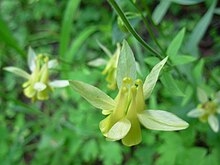Aquilegia flavescens
| Aquilegia flavescens | |
|---|---|

| |
| Scientific classification | |
| Kingdom: | Plantae |
| Clade: | Tracheophytes |
| Clade: | Angiosperms |
| Clade: | Eudicots |
| Order: | Ranunculales |
| Family: | Ranunculaceae |
| Genus: | Aquilegia |
| Species: | A. flavescens
|
| Binomial name | |
| Aquilegia flavescens | |
| Synonyms[2] | |
|
List
| |
Aquilegia flavescens, the yellow columbine, is a perennial species of flowering plant in the family Ranunculaceae, native to the Rocky Mountains of the United States and Canada.[2]
Description
[edit]Aquilegia flavescens grows to 20–70 cm (7.9–27.6 in) in height. The leaves are smooth or downy, and the stems are glandular pubescent. The flowers are nodding and the sepals usually yellow, but sometimes yellowish-pink or raspberry pink, reflexed, and 12–20 mm (0.47–0.79 in) in length. The petal blades are white or cream and 7–10 mm (0.28–0.39 in) long, with the stamens extending beyond them. The nectar spurs are yellow to raspberry pink, slightly curved, and measure 10–20 mm (0.39–0.79 in).[3]
Taxonomy
[edit]The species is part of a clade containing all the North American species of columbines, that likely split from their closest relatives in East Asia in the mid-Pliocene, approximately 3.84 million years ago.[4]
Etymology
[edit]The specific epithet flavescens means "yellowish" in Latin.
Distribution and habitat
[edit]The species is native to mountain meadows, open woods, and alpine slopes of the Rocky Mountains of eastern Utah, Idaho, eastern Washington, northeastern Oregon, western Montana, northeastern Wyoming, and southern British Columbia and Alberta.[3] It grows at altitudes of 1,300–3,500 m (4,300–11,500 ft).[5]
Ecology
[edit]Aquilegia flavescens is pollinated by hummingbirds[4] and visited by bumblebees including the common carder bee and the golden-belted bumblebee.[6] It flowers from June to August and sometimes forms hybrid swarms with Aquilegia formosa var. formosa, which grows at lower elevations throughout much of its range.[5]
Conservation
[edit]As of November 2024[update], NatureServe listed Aquilegia flavescens as Secure (G5) worldwide. This status was last reviewed on 13 May 2016. In individual provinces and states, it is listed as Secure (G5) in British Columbia; Apparently Secure (S4) in Alberta, Montana, and Wyoming; and has no status rank in Washington, Oregon, Idaho, Utah, or Colorado.[1]
References
[edit]- ^ a b "Aquilegia flavescens Yellow Columbine". NatureServe. Retrieved 9 November 2024.
- ^ a b "Aquilegia flavescens S.Watson". Plants of the World Online. Royal Botanic Gardens, Kew. Retrieved 9 November 2024.
- ^ a b "Aquilegia flavescens, yellow columbine". United States Forest Service. USDA. Retrieved 9 November 2024.
- ^ a b Fior, Simone; Li, Mingai; Oxelman, Bengt; Viola, Roberto; Hodges, Scott A.; Ometto, Lino; Varotto, Claudio (2013). "Spatiotemporal reconstruction of the Aquilegia rapid radiation through next-generation sequencing of rapidly evolving cpDNA regions". New Phytologist. 198 (2): 579–592. doi:10.1111/nph.12163. PMID 23379348.
- ^ a b Whittemore, Alan T. (1997). "Aquilegia flavescens". In Flora of North America Editorial Committee (ed.). Flora of North America North of Mexico (FNA). Vol. 3. New York and Oxford: Oxford University Press. Retrieved 9 November 2024 – via eFloras.org, Missouri Botanical Garden, St. Louis, MO & Harvard University Herbaria, Cambridge, MA.
- ^ "Aquilegia flavescens" at the Encyclopedia of Life

